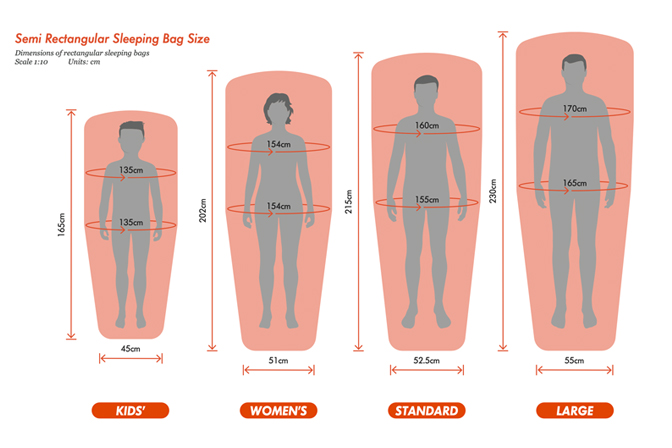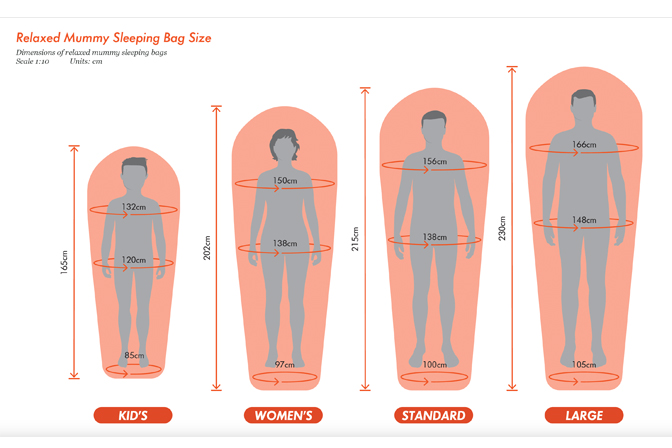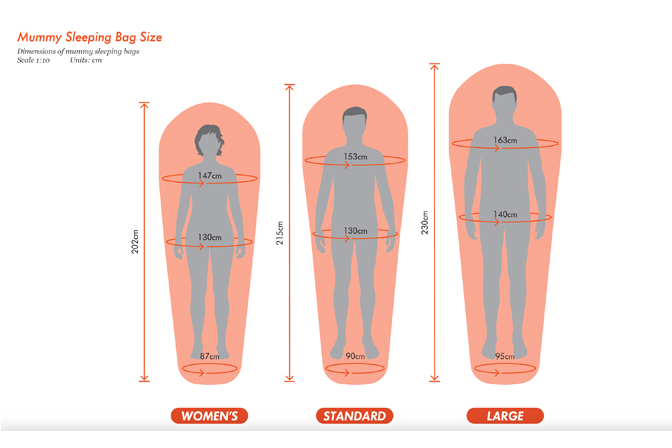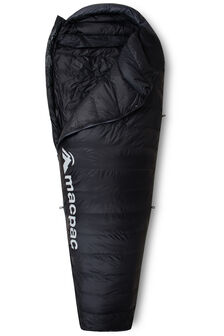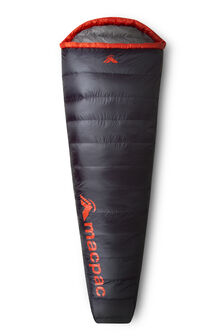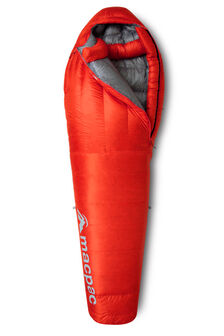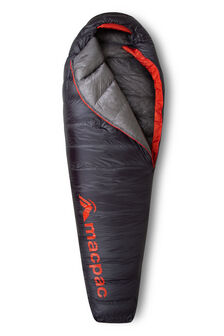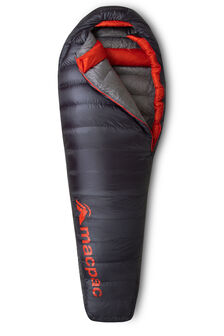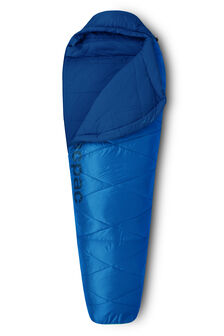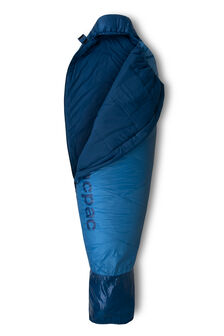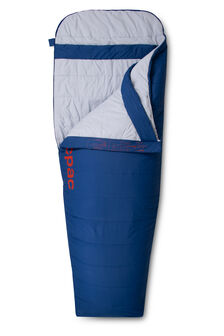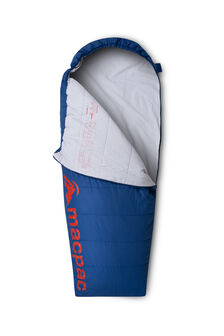
The importance of a good night’s sleep in the outdoors can’t be overstated — and your sleeping bag is critical to this. But whether you’re looking for your first sleeping bag, or upgrading your current model, it can be daunting. There’s a lot to consider. This guide will help you understand everything you need to know about choosing the perfect sleeping bag for you and your intended activity.
Start by considering these factors
- Activity: What is the main activity you need the bag for? For instance, summer camping trips vs. overnight alpine expeditions will have very different requirements.
- Budget: Macpac has a great variety of sleeping bags to suit your budget. Once you’ve determined your sleeping bag requirements (where will you use it, what conditions will you use it in etc) you can choose a bag that fits your budget.
- Temperature rating: What season are you adventuring in?
- Type of insulation: Should you go for down or synthetic? Both have their pros and cons.
- Shape and sizing: Sleeping bags come in different shapes that each perform differently.
- Packed size: Fill, shape and size affect the compressibility of your sleeping bag, which then affects the packed size — a measure that’s important if you plan on carrying your sleeping bag.
- Weight: Like the above point, the physical weight of your sleeping bag will play a role if you’re carrying all your gear (during activities like hiking or thru-hiking).
- Other considerations: Additional features like sleeping mat attachments, internal draft tubes, side ventilation zips, or even hut walking functions can all add to ease and convenience of the bag, making it the winner between two close considerations.
1. What activity are you doing?
It helps to identify the main activity you will be using the sleeping bag for, as different activities may have very different requirements.
Camping
Sleeping bags that are well suited to camping and road trips are designed around comfort. Weight or packability is generally less of a priority since you’re likely to be heading to your destination by car. Synthetic bags are a great option here as they are easy to care for, and more affordable than their down counterparts.
Our Pick: Check out our synthetic sleeping bag options, the Roam 200 or Aspire 360, or down sleeping bags like the Dusk 400 or Escapade 500.
Lightweight trips (like thru-hiking or bikepacking)
If your priority is to move light and cover ground, you probably don’t want to be weighed down by your sleeping bag. Look for sleeping bags that minimise weight and maximise compressibility.
Our Pick: Dragonfly 400 and Dragonfly 600 or the ultralight Firefly 200. These bags have been rigorously tested by our ambassadors, including members of the New Zealand Alpine Team, where minimising weight is always a goal.
Hiking
In general, sleeping bags designed for hiking tend to be lightweight and packable, with more warmth for the weight. If you’re looking for a versatile option, it’s possible to pair a 3-season sleeping bag with other additions to improve its temperature rating, e.g. a liner and extra clothing layers.
Our Pick: Dragonfly 400 and Dragonfly 600, and the Azure 500 and Azure 700.
Alpine
For alpine trips you need a sleeping bag that provides excellent insulation in cold environments.
Our Pick: The Serac 1000, our flagship alpine sleeping bag. It features 1000g of 800 loft HyperDRY™ goose down to provide high-quality, water-resistant warmth. Perfect for camping above the snowline.
2. What’s your budget?
Sleeping bags can vary greatly in price depending on the activity they're designed for, their construction and their features. First, determine your requirements and then choose a bag that fits your budget. You may need to compromise in weight or compressibility but make sure the sleeping bag you choose is warm enough for the conditions you are planning on using it in. Down-filled sleeping bags tend to be more expensive than synthetic sleeping bags but they're warmer and more compressible. If cared for correctly your down sleeping bag will be a trusted companion for many years.
3. What temperature rating should you choose?
A sleeping bag's temperature rating identifies the ranges at which a bag is designed to keep an “average sleeper” warm. This will give you a general idea about a sleeping bag’s performance and is useful for comparing bags. You will notice our sleeping bags have three ratings on them.
- Comfort: the temperature at which the average female (or cold sleeper) can expect to sleep comfortably.
- Limit: the temperature at which the average man (or warm sleeper), will not feel cold.
- Extreme: the temperature at which the average woman will be at risk of hypothermia. This is a ‘survival only’ rating.
In short, you want to select a sleeping bag with a comfort temperature rating that’s lower than the lowest temperature you expect to encounter.
It’s important to note sleeping bag temperatures are not a guarantee of warmth and shouldn’t be considered in isolation. In reality, several factors can determine how cold or warm you feel during use, such as your sleep system (sleeping mats, liners etc.), conditions on the day, your energy levels, the clothing you’re wearing when sleeping and even your food intake throughout the day.
Did you know: At Macpac we advertise the comfort temperature rating on our women's and kid's sleeping bags, and the limit temperature rating for our standard and large sleeping bags. Macpac adult sleeping bags are tested to the ISO 23537-1 international standard and temperatures are in degrees Celsius (°C). Our kids’ sleeping bags have been tested to the international ASTMF1720 standard. This test takes into account that metabolic heat production decreases with age. This is why temperature ratings on our kids' sleeping bags get smaller as they grow older.
4. What type of insulation should you choose?
Synthetic insulation
Synthetic bags offer solid performance at an affordable price. Macpac’s new synthetic sleeping bags are filled with recycled polyester.
Pros:
- Will continue to insulate in damp conditions
- Can be a good choice if you have allergies to down.
- Easy to care for and wash
Cons:
- Typically heavier/not as compressible as down options.
Down insulation
Down sleeping bags are filled with duck or goose down. At Macpac we only use down that is ethically sourced (certified by the Responsible Down Standard). Down sleeping bags are typically more expensive than their synthetic counterparts, but down’s warmth-to-weight ratio is better than any synthetic fill.
Pros:
- Great warmth to weight ratio
- Highly compressible
- HyperDRY™ water resistant down is treated with a fluorocarbon-free treatment. This causes water to bead and roll off the down cluster so it can retain its loft, and therefore its ability to retain warmth, when exposed to moisture.
Cons:
- Don’t perform as well as synthetic bags when wet
- Generally more expensive than synthetic bags
- Requires more care than synthetic bags (see how to wash your sleeping bag for more)
5. What sleeping bag shape should you choose?
Sleeping bag shapes
Temperature ratings aside, size and shape are key to finding the right sleeping bag. The sleeping bag you buy needs to be sized appropriately to your measurements and account for the clothing you’re planning on wearing when sleeping in your bag. An overly tight fit can feel too restrictive and can compress the insulation. When this happens to down fill sleeping bags in particular, the down is unable to fully loft which will compromise performance and mean it won’t be as warm.
Semi Rectangular These bags are wide at the shoulders with relatively square footboxes. They’re perfect for travel and car camping because they can be opened out into quilts. The roomier shape allows you to roll around more naturally like sleeping at home.
Relaxed Mummy Narrower at the shoulders and hips, relaxed mummy bags taper towards the footbox for a more technical fit that still lets you move around. Ideal for most hikers.
Mummy Narrower at the shoulders and hips, this technical fit provides the best warmth-to-weight ratios for serious adventurers. At Macpac we reserve this shape for the lightweight Firefly 200, alpine-ready Serac 1000, and minimalist Dragonfly range.
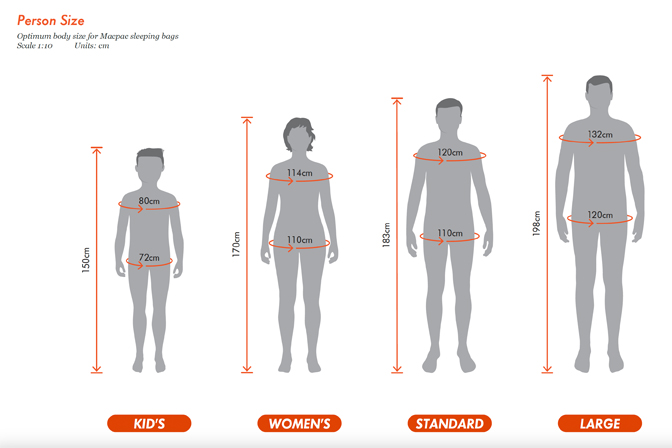
Sleeping bag sizes
This chart details the optimum body sizes for our sleeping bags
Kids
Kids’ sleeping bags are designed to be comfortable for children, and ideal for family camping in moderate temperatures. The Aspire 270 has a handy ‘Grow with me’ system so you can shorten it for smaller kids.
Women’s specific
Women’s specific sleeping bags are narrower at the shoulders and shorter in length, but with the same amount of fill as standard sizes. The ‘extra’ down is redistributed differently across the top and footbox to provide greater warmth and cater to women’s physiologies.
Standard
This is your ‘regular’ or average size sleeping bag.
Large
Large sleeping bags are longer and wider across the top to fit taller, broader frames better.
6. Packed size
You want to make sure your sleeping bag can easily fit inside whatever pack you’re carrying, so this is where its packed size comes into play. Apart from the sleeping bag’s measurements, you can also use a compression sack to help further compress your bag and provide extra waterproof protection.
7. Weight
When diving into the specs of a sleeping bag, note the total sleeping bag weight. This is what matters when you’re carrying a bag in your pack. The type of insulation and overall shape has the greatest impact on total weight, so bear this in mind when comparing temperature ratings with other specifications. As a rule, down is a more efficient insulator — and it will deliver greater warmth than synthetic fill for less weight— but for a higher price. In general, our advice is to go as lightweight as your budget allows bearing in mind the temperature rating you need for your chosen activity.
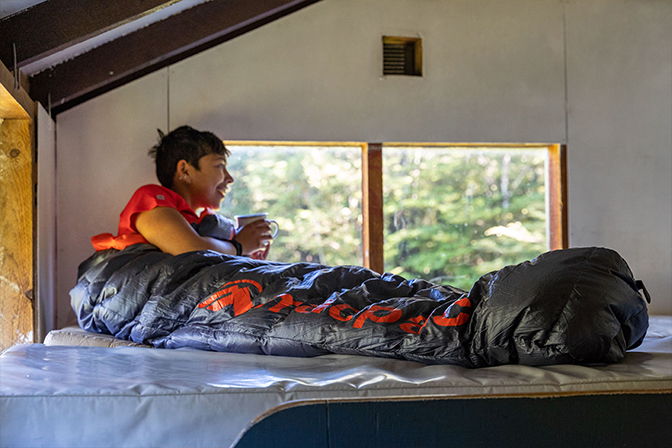
8. Other considerations
- Sleeping bag liners offer an extra layer of warmth when paired with your sleeping bag and will help keep your bag clean during use, ultimately extending its life. Check out our range of sleeping bag liners.
- Sleeping mats play a crucial role in providing a layer of insulation between you and the ground. To fully optimize the insulation capabilities of your sleeping bag, it's important you have a quality mat to sleep on. Even with a warm sleeping bag, the absence of a sleeping mat can leave you susceptible to feeling the cold from the ground. The general rule is sleeping mats with higher R-Values will keep you warmer than those with lower R-values. Check out our range of sleeping mats to find the right one for you.
- Sleeping bag features can add comfort and convenience to your sleep experience — For example, sleeping mat attachments to prevent you rolling off your mat during the night, internal draft tubes to help keep warm air from escaping, stash pockets for your phone or smaller items, side zips for ventilation, and the ability to zip compatible sleeping bags together to create a large blanket or quilt.
We hope that provides a comprehensive overview of how to choose a sleeping bag. Macpac sleeping bags have been loved by generations of trampers and trusted on everything from the toughest alpine expeditions to everyday family camping trips.
Today the range feels stronger than ever. And our goal is to help you find the perfect bag for you. If you’re ever in doubt, make sure to head into our store and chat to one of our product experts.
Macpac Standard Dusk 400 Down Sleeping Bag (-3°C)
Our Price
A$330.99MEMBERS PRICE
38% OFFCLEARANCE
38% OFFSALE
38% OFFMacpac Standard Firefly 200 Down Sleeping Bag (3°C)
Our Price
A$349.99MEMBERS PRICE
30% OFFCLEARANCE
30% OFFSALE
30% OFFMacpac Standard Serac 1000 Down Sleeping Bag (-17°C)
Our Price
A$824.99MEMBERS PRICE
25% OFFCLEARANCE
25% OFFSALE
25% OFFMacpac Standard Dragonfly 400 Down Sleeping Bag (-5°C)
Our Price
A$524.99MEMBERS PRICE
25% OFFCLEARANCE
25% OFFSALE
25% OFFMacpac Standard Dragonfly 600 Down Sleeping Bag (-10°C)
Our Price
A$637.49MEMBERS PRICE
25% OFFCLEARANCE
25% OFFSALE
25% OFFMacpac Large Aspire 360 Synthetic Sleeping Bag (-10°C)
Our Price
A$168.99MEMBERS PRICE
37% OFFCLEARANCE
37% OFFSALE
37% OFFMacpac Kids' Aspire 270 Synthetic Sleeping Bag (1.8°C)
Our Price
A$98.99MEMBERS PRICE
42% OFFCLEARANCE
42% OFFSALE
42% OFFMacpac Standard Roam 200 Synthetic Sleeping Bag (-1°C)
Our Price
A$119.99MEMBERS PRICE
40% OFFCLEARANCE
40% OFFSALE
40% OFFMacpac Kids' Roam 160 Synthetic Sleeping Bag (7.5°C)
Our Price
A$77.99MEMBERS PRICE
44% OFFCLEARANCE
44% OFFSALE
44% OFF

